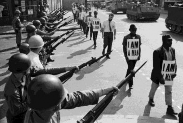<< LAST Contents NEXT >>
GUIDELINES FOR A CIVIL RIGHTS MARCH

Definition:
A Civil Rights March is not a celebration but a nonviolent direct action against a specific injustice demanding a very specific response from the adversary. These guidelines are from Gandhi.
A Civil Rights March:
- has a specific, narrowly-focused, clearly-stated goal
- is not an end in itself but one tactic in a total strategy to reach a specific goal
- is only called for after negotiations have broken down with an adversary and then only to compel the adversary back to negotiations
- is costly (in time, money, and energy) to volunteers and the organizations they represent and that cost must be honestly and openly considered before the march is called
- is timed for maximum effect
- must require risk, courage, and stamina for the marcher (to demonstrate the marcher’s total commitment and genuine concern)
- is a serious-minded attempt to persuade the adversary that the request is just. A march is not a parade, party, or celebration that may confuse the adversary or even give the adversary more reason to hate or fear the marchers
- is not called to support a candidate, party, or issue which may divide the marchers, but a specific goal or purpose upon which the marchers are united
- must focus the print and electronic media on the specific, clearly-stated, narrowly-focused goal before, during, and after the march to avoid any confusion about the goal
- must be directed by carefully trained monitors and before the march all marchers must agree to obey those monitor’s commands
- must not seek to embarrass, coerce or terrorize the adversary, but quietly, calmly, and courageously convince the adversary that the marcher’s goal is just.
A Civil Rights Marcher:
- must be carefully trained in the goal of the march & sign a pledge to maintain standards of behavior & dress during the march that will convince the adversary that the marcher is determined & sincere
- must understand the principles of nonviolence and pledge to refrain from violence of fist, tongue, or heart during the march.
- A marcher must be a person of faith
Note:
Neither Gandhi nor King required sectarian allegiance to anyone statement of faith or religious practice, but both men stated clearly that a truly nonviolent march cannot be carried out by marchers without some faith commitment.
Do you agree?


